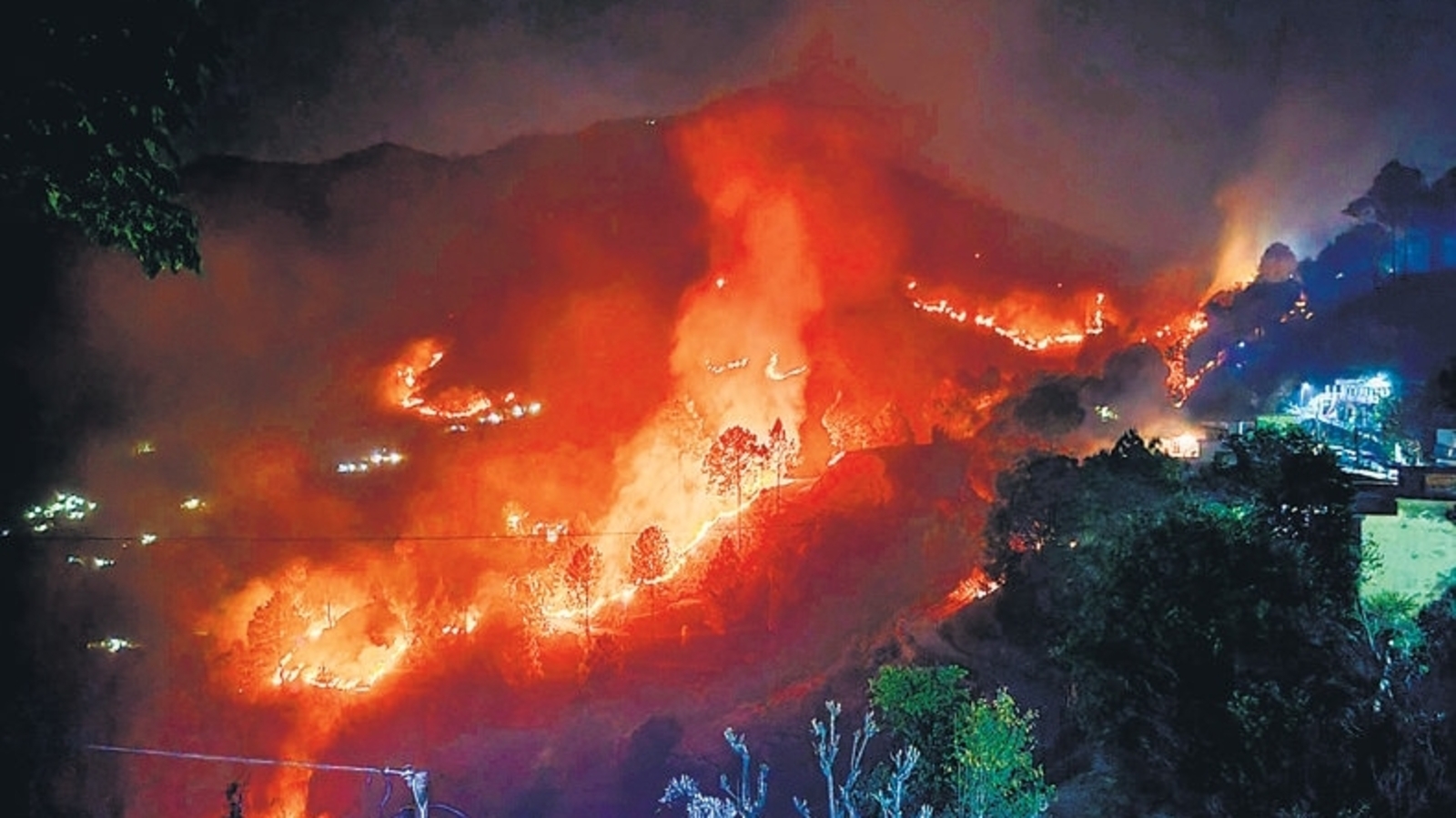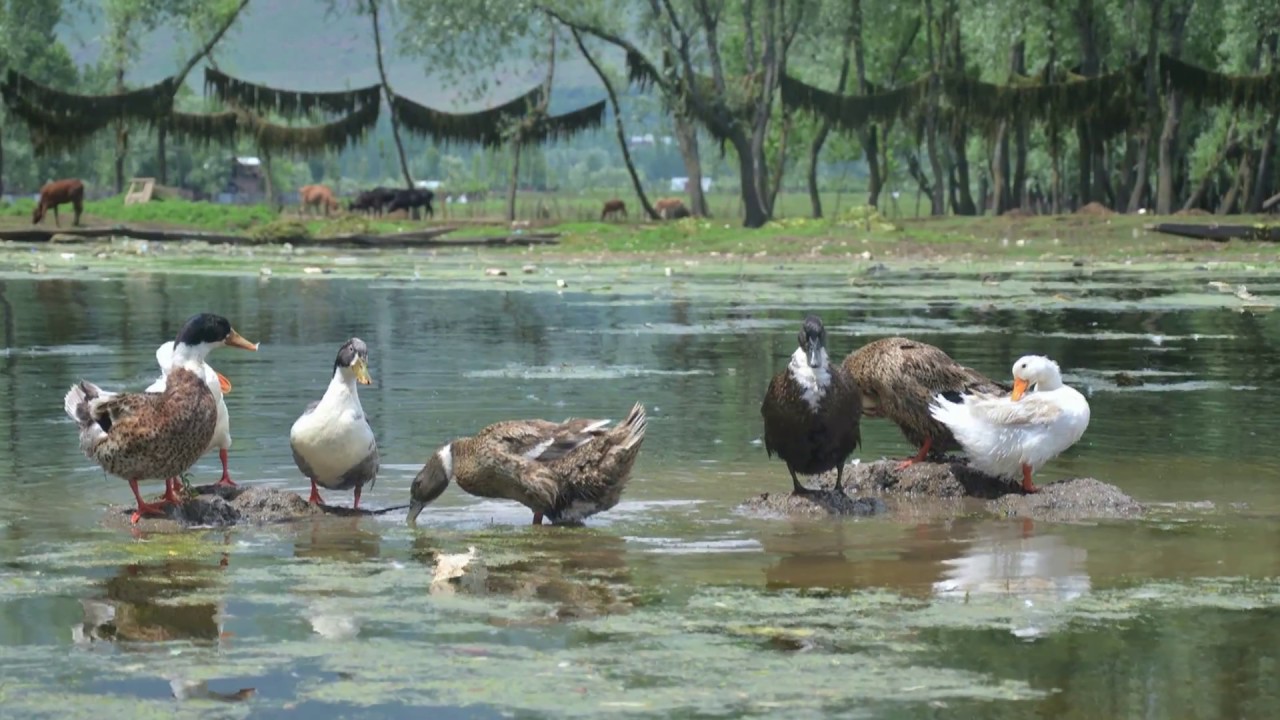Kashmir’s Green Gold Burns: Five Major Fire Incidents in 24 Hours
By: Javid Amin
Srinagar, February 17, 2025 – Kashmir is currently facing a severe environmental crisis as forest fires rage across the region amid a prolonged dry spell. In the past 24 hours alone, five major fire incidents have been reported in different districts, including Tral, Gulshanpora, Panner, Nahwadi Pinglish, and Karmula. These fires have caused significant damage to the region’s green cover and raised alarm among environmentalists and local residents alike.
Current Situation and Response
The ongoing dry spell has created an environment primed for wildfires, with strong winds exacerbating the situation. Forest officials have mobilized firefighting teams, including personnel from the Wildlife Department, Forest Department, Social Forestry, National Disaster Response Force (NDRF), Central Reserve Police Force (CRPF), and local residents, to contain the flames. “Ninety-five percent of the fire in the Pinglish wildlife zone has been controlled, with no active flames remaining – only smoke from decayed stumps. The fire in Panzoo forest has been completely extinguished,” an official said. Despite these efforts, the fires have already caused significant damage to the local flora and fauna.
Environmental Impact
Environmentalists fear that the fires may have impacted wildlife habitats and biodiversity in the affected areas. The dry spell has left the forests highly susceptible to fires, and even a small spark can lead to a devastating wildfire. The absence of rain and snowfall has left the forests dry and vulnerable. Chief Conservator of Forests (CCF), Kashmir, Irfan Rasool Wani, acknowledged the increasing number of forest fires and attributed them to the prolonged dry conditions. “Fortunately, none of the fires so far have been extremely severe,” he noted.
Details of Recent Fire Incidents
- Pinglish Shikargah Wildlife and Forest Area, Tral: A massive fire broke out on Saturday evening, quickly spreading to nearby areas, including Kamla, Karmulla, Lurgam, and Panzoo. A joint team comprising the Forest Department, Wildlife Department, Social Forestry, NDRF, CRPF, and locals rushed to contain the blaze. Nearly 95% of the fire has been brought under control.
- Brar Salia Village, Anantnag District: Another fire erupted on Sunday evening, affecting approximately six kanal forest land before being brought under control.
- Dadoo, Marhama Village, Bijbehara: A simultaneous fire broke out, damaging a significant portion of green cover.
- Compartment 20/K, Aloosa, Khuihama Village, Bandipora District: A major blaze was reported earlier that morning.
- Compartment 110/K, Arin, Ajas, Bandipora District: A separate fire was also reported in this area.
Emergency response teams, including the Forest Department and Forest Protection Force (FPF), acted swiftly to prevent further spread. “The fire engulfed vast stretches of forest land but was controlled in time,” an official said.
Factors Contributing to Forest Fires
Experts point to both climate factors and human negligence as the primary causes of these fires. The prolonged dry spell has heightened the susceptibility of the forests to fires, and a significant number of such incidents have been reported recently. The National Disaster Management Authority (NDMA) and Forest Survey of India (FSI) had already issued a warning in late January about a heightened risk of forest fires. In response, the Forest Department, Wildlife Department, Fire and Emergency Services, and Disaster Management Authority are on high alert to tackle such incidents. Officials have urged residents to report any signs of fire immediately to Fire and Emergency Services to prevent escalation.
Human Activities and Preventive Measures
While some forest fires occur naturally, human activities significantly contribute to their frequency and intensity. Divisional Forest Officer (DFO) Lidder Division, Shama Roohi, cautioned against practices like illegal coal and wood collection, which can inadvertently ignite fires. “Given the dry conditions, it is crucial to avoid entering forests and lighting any form of fire. Forests are our natural wealth, and it is our collective responsibility to protect the green gold,” she stated. Environmental experts have already raised an alarm that rising temperatures and extended dry spells, likely linked to climate change, may lead to an increase in the frequency and intensity of forest fires in Kashmir.
Community Involvement and Cooperation
Authorities are urging the public to remain vigilant and report any fire incidents immediately. The Forest Department has ramped up surveillance efforts and is coordinating with local disaster response teams to mitigate potential risks. Residents are being encouraged to avoid activities like burning dry grass or discarding cigarette butts in forested areas. Community involvement and cooperation are crucial in preventing further damage and ensuring a sustainable future for Kashmir’s forests.
Long-Term Solutions
To avoid forest fires, it is essential to strictly regulate human activities that pose fire risks. Educating campers and hikers about fully extinguishing campfires, avoiding smoking in forest areas, and properly disposing of flammable materials is key. Installing and maintaining firebreaks—gaps in vegetation that help prevent fires from spreading—can significantly reduce the risk of uncontrollable fires. Additionally, promoting reforestation and sustainable land management practices can help restore the ecological balance and reduce the vulnerability of forests to fires.
Climate Change and Its Impact on Forest Fires
Environmental experts emphasize the role of climate change in exacerbating the frequency and intensity of forest fires. Rising temperatures and extended dry spells, likely linked to climate change, have created conditions conducive to wildfires. “Climate change is having a profound impact on our forests. We need to take urgent action to mitigate its effects and adapt to the changing climate to protect our environment and livelihoods,” said Dr. Mansha Nisar, an environmental scientist.
The Role of Technology in Forest Fire Management
The integration of technology can play a crucial role in forest fire management. Utilizing remote sensing and satellite imagery can help in early detection and monitoring of forest fires. Geographic Information Systems (GIS) can be used to map fire-prone areas and assess the extent of damage. Drones equipped with thermal cameras can provide real-time data and assist in firefighting efforts. Implementing these technological solutions can enhance the efficiency and effectiveness of forest fire management.
Impact on Jammu and Kashmir’s Economy and Biodiversity
Jammu and Kashmir has a forest cover of 21,387 sq km and a tree cover of 2867 sq km, constituting about 10 percent of its total geographical area. The region’s forests, predominantly dry temperate, are home to valuable species like Deodar, Kail, and Fir, which thrive at different altitudes. The loss of green cover due to forest fires can have severe implications for the region’s economy and biodiversity. Forests play a vital role in supporting the livelihoods of local communities, providing habitat for wildlife, and maintaining ecological balance. The degradation of forest ecosystems can lead to a decline in biodiversity, disruption of ecosystem services, and increased vulnerability to natural disasters.
Recent Forest Fire Incidents and Risk Factors
Several forest fires were reported in December, particularly in the Chenab Valley, but these subsided following the season’s first snowfall in late December. However, with no significant precipitation since then, the risk remains high. The dry conditions, coupled with human activities such as illegal logging and land clearing, have contributed to the increased frequency and intensity of forest fires. Effective forest management practices, including regular monitoring, fire prevention measures, and community engagement, are essential to mitigate the risks and protect the region’s green cover.
The Need for Policy Interventions and Sustainable Practices
Policy interventions and sustainable practices are crucial to address the ongoing environmental crisis and ensure the long-term resilience of Jammu and Kashmir’s forests. Policymakers must prioritize the implementation of comprehensive forest fire management plans, incorporating scientific research, technological advancements, and community participation. Sustainable land use practices, afforestation, and reforestation initiatives should be promoted to restore degraded areas and enhance the region’s ecological balance. Additionally, raising awareness about the importance of forest conservation and the impacts of climate change can foster a sense of responsibility and collective action among stakeholders.
Bottom-Line
The forest fires in Kashmir highlight the urgent need for sustainable environmental practices and long-term solutions to address the ongoing dry spell and its impact on the region’s green cover. Community involvement and cooperation are crucial in preventing further damage and ensuring a sustainable future for Kashmir’s forests. By adopting a holistic approach that integrates technology, policy interventions, and community engagement, we can mitigate the risks of forest fires and protect the region’s valuable natural resources.



